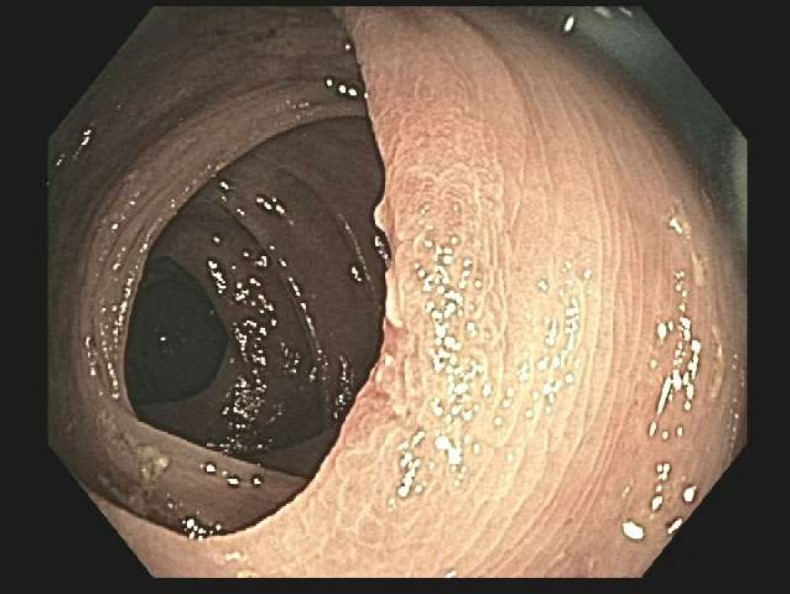Sunday Poster Session
Category: Colon
P0356 - A Case of Polyethylene Glycol-Induced Ischemic Colitis
Sunday, October 26, 2025
3:30 PM - 7:00 PM PDT
Location: Exhibit Hall
- SD
Shaan H. Desai, MD (he/him/his)
Temple University Hospital
Philadelphia, PA
Presenting Author(s)
Shaan H. Desai, MD1, Neena Mohan, MD2
1Temple University Hospital, Philadelphia, PA; 2Temple University, Philadelphia, PA
Introduction: Modern bowel preparation agents, such as polyethylene glycol (PEG), have proven safe and efficacious. Ischemic colitis is a rare complication of pre-colonoscopy bowel preparation, with few cases citing bisacodyl alone or along with PEG as the causative agent. Here, we present a case of PEG and electrolyte-induced ischemic colitis.
Case Description/
Methods: A 74-year-old female with a past medical history of metabolic syndrome, osteoarthritis, and osteoporosis presented to our endoscopy center for routine colorectal cancer screening after undergoing preparation with PEG-3350 and electrolytes. Colonoscopy showed fair preparation with localized inflammation characterized by erythema and diminutive ulceration in the splenic flexure (see Figure 1). Additionally, two areas of segmental inflammation characterized by erythema and shallow ulceration were found in the sigmoid colon (see Figure 2). Biopsies were taken from all three areas and demonstrated ischemic colitis on histology. The patient only reported occasional abdominal pain without any other symptoms. Furthermore, she did not take any concomitant laxatives. Complete blood count, comprehensive metabolic panel, C-reactive protein, and prothrombin time were all within normal limits. A computed tomography angiogram of the abdomen and pelvis did not show any significant stenosis or atherosclerotic disease that would explain the patient's biopsy findings. She is scheduled for a follow-up and plans for a repeat colonoscopy in the future.
Discussion: Ischemic colitis is typically associated with colonic hypoperfusion. Pharmacologic agents are a rare cause of ischemic colitis, with osmotic laxatives, such as PEG, being even rarer. The proposed mechanism for osmotic laxatives involves a rapid shift of fluid into the colonic lumen, resulting in lower intravascular volumes and colonic hypoperfusion. Prior case reports have described bisacodyl and PEG with bisacodyl-associated ischemic colitis; however, no prior case reports describe ischemic colitis with PEG alone. While PEG is considered highly safe and efficacious, this case is suggestive of an infrequent episode of PEG-induced ischemic colitis.

Figure: Localized erythema and shallow ulcerations of the splenic flexure.

Figure: Erythema and ulceration of the sigmoid colon.
Disclosures:
Shaan Desai: Bristol–Myers Squibb – Stock-publicly held company(excluding mutual/index funds). Johnson & Johnson – Stock-publicly held company(excluding mutual/index funds). Medtronic – Stock-publicly held company(excluding mutual/index funds).
Neena Mohan: Cyted – Advisory Committee/Board Member.
Shaan H. Desai, MD1, Neena Mohan, MD2. P0356 - A Case of Polyethylene Glycol-Induced Ischemic Colitis, ACG 2025 Annual Scientific Meeting Abstracts. Phoenix, AZ: American College of Gastroenterology.
1Temple University Hospital, Philadelphia, PA; 2Temple University, Philadelphia, PA
Introduction: Modern bowel preparation agents, such as polyethylene glycol (PEG), have proven safe and efficacious. Ischemic colitis is a rare complication of pre-colonoscopy bowel preparation, with few cases citing bisacodyl alone or along with PEG as the causative agent. Here, we present a case of PEG and electrolyte-induced ischemic colitis.
Case Description/
Methods: A 74-year-old female with a past medical history of metabolic syndrome, osteoarthritis, and osteoporosis presented to our endoscopy center for routine colorectal cancer screening after undergoing preparation with PEG-3350 and electrolytes. Colonoscopy showed fair preparation with localized inflammation characterized by erythema and diminutive ulceration in the splenic flexure (see Figure 1). Additionally, two areas of segmental inflammation characterized by erythema and shallow ulceration were found in the sigmoid colon (see Figure 2). Biopsies were taken from all three areas and demonstrated ischemic colitis on histology. The patient only reported occasional abdominal pain without any other symptoms. Furthermore, she did not take any concomitant laxatives. Complete blood count, comprehensive metabolic panel, C-reactive protein, and prothrombin time were all within normal limits. A computed tomography angiogram of the abdomen and pelvis did not show any significant stenosis or atherosclerotic disease that would explain the patient's biopsy findings. She is scheduled for a follow-up and plans for a repeat colonoscopy in the future.
Discussion: Ischemic colitis is typically associated with colonic hypoperfusion. Pharmacologic agents are a rare cause of ischemic colitis, with osmotic laxatives, such as PEG, being even rarer. The proposed mechanism for osmotic laxatives involves a rapid shift of fluid into the colonic lumen, resulting in lower intravascular volumes and colonic hypoperfusion. Prior case reports have described bisacodyl and PEG with bisacodyl-associated ischemic colitis; however, no prior case reports describe ischemic colitis with PEG alone. While PEG is considered highly safe and efficacious, this case is suggestive of an infrequent episode of PEG-induced ischemic colitis.

Figure: Localized erythema and shallow ulcerations of the splenic flexure.

Figure: Erythema and ulceration of the sigmoid colon.
Disclosures:
Shaan Desai: Bristol–Myers Squibb – Stock-publicly held company(excluding mutual/index funds). Johnson & Johnson – Stock-publicly held company(excluding mutual/index funds). Medtronic – Stock-publicly held company(excluding mutual/index funds).
Neena Mohan: Cyted – Advisory Committee/Board Member.
Shaan H. Desai, MD1, Neena Mohan, MD2. P0356 - A Case of Polyethylene Glycol-Induced Ischemic Colitis, ACG 2025 Annual Scientific Meeting Abstracts. Phoenix, AZ: American College of Gastroenterology.
